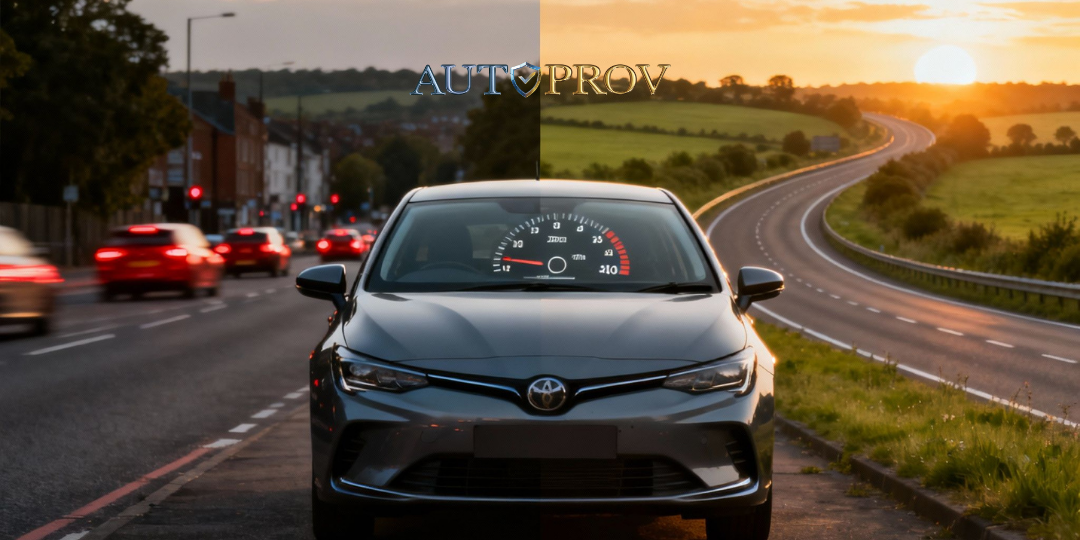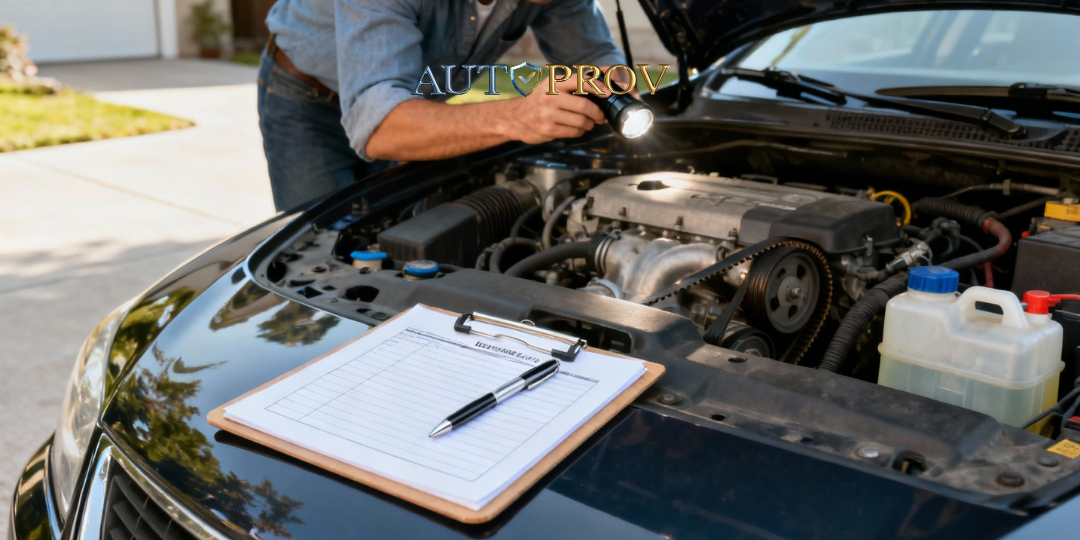
When you're hunting for a used car, one of the first things you’ll probably look at is the mileage. It's a quick, easy number to latch onto. But what actually counts as ‘good mileage’ in the UK?
When you're hunting for a used car, one of the first things you’ll probably look at is the mileage. It's a quick, easy number to latch onto. But what actually counts as ‘good mileage’ in the UK?
As a rule of thumb, a good mileage for a used car is anything below the national average, which currently sits at about 7,000 miles per year of its life. But that simple figure is just the start of the conversation. Think of it less as a final grade and more as the first clue in a car's life story.
Setting the Right Mileage Benchmark
It’s completely natural to glance at the odometer first. We’ve all been conditioned to think lower is better, but mileage can be a bit of a red herring if you don't have the full picture. A car with 60,000 miles isn't automatically a better buy than one showing 90,000.
What really matters is how those miles were put on the clock. Imagine a car that's spent its life cruising up and down the motorway. Those long, steady journeys are relatively gentle on the engine, brakes, and gearbox. Now, compare that to a car with much lower mileage that’s only ever been used for the school run in stop-start city traffic. The constant braking, short trips, and cold starts are far more demanding on its mechanical parts.
The annual average of 7,000 miles is your baseline. A car clocking up significantly more might have been a company vehicle eating up motorway miles, while one with far fewer could be a weekend run-around. Neither is automatically a bad thing, but they tell very different stories.
To give you a quick way to size up any car you're looking at, here’s a handy reference guide based on that UK average.
How UK Driving Habits Have Changed the Mileage Game
When you're trying to figure out what good mileage is for a used car, a simple comparison between a fifteen-year-old model and a five-year-old one just won't cut it. The goalposts for what’s considered ‘average’ have moved, a lot. A car from the early 2000s lived in a completely different driving world, and its odometer tells that story.
To make a smart choice, you have to understand this history. Before remote working and Zoom calls became the norm, business travel was a massive contributor to annual mileage. Countless saloons and estates spent their lives eating up motorway miles for work.
The Great Mileage Slowdown
That whole pattern has changed. Over the last two decades, the average annual car mileage in the UK has dropped off a cliff. Back in 2003, a typical car would cover 9,200 miles a year. Fast forward to 2023, and that number is down to just 7,000 miles—that's a 24% decline. A huge part of this was a 67% nosedive in business driving, which fell from 1,200 miles a year to only 400. You can discover more insights about these UK driving trends and see the full data.
This shift means you’ve got to look at cars from different eras with the right perspective.
A 10-year-old car with 90,000 miles on the clock might seem high by today’s standards, but it was perfectly normal for its time. Judging it against a 2023 average would be misleading.
Context Is Everything When Judging the Numbers
So, what does this actually mean for your car search? Simple: context is king. A higher-mileage older car isn’t automatically a write-off, just as a low-mileage newer car isn't a guaranteed gem.
Here’s how to put this into practice:
- For Older Cars (10+ years): Expect higher annual averages, somewhere closer to that 9,000-mile mark. Your focus should be squarely on the service history to see if it was looked after during its busier years.
- For Newer Cars (1-5 years): The 7,000-mile average is a much more realistic benchmark. If you see mileage well above this, it could be a red flag for heavy use, like taxi work or courier deliveries.
By recalibrating your expectations based on the car's age, you can make a much fairer and more accurate call on whether those numbers on the odometer are a cause for concern.
Why Not All Miles Are Created Equal
The number on a car’s odometer only tells you the distance it’s travelled, not the story of its journey. Think of it like this: two runners have both covered 50 miles. One ran on a flat, smooth track at a steady pace, while the other navigated a chaotic urban obstacle course. They covered the same distance, but their bodies endured completely different levels of stress.
It’s exactly the same with cars. This is the crucial difference between ‘easy’ motorway miles and ‘hard’ city miles. A car that has spent most of its life cruising at a consistent speed in top gear has had a relatively gentle existence. Its engine has been humming along at its optimal temperature, the gearbox hasn’t been constantly shifting, and the brakes have been used sparingly.
The Strain of City Driving
In contrast, urban driving is the automotive equivalent of a high-intensity workout. The relentless stop-start traffic places immense strain on the entire vehicle.
- Engine and Drivetrain: Constant acceleration and braking put heavy wear on the engine, clutch, and transmission.
- Brakes and Suspension: These components are working overtime, leading to faster wear on brake pads, discs, and suspension joints.
- Short Trips: Cars used for quick jaunts to the shops rarely reach their ideal operating temperature. This can cause moisture to build up, leading to premature wear on the engine and exhaust system.
Because of this, a car with 70,000 motorway miles could easily be in better mechanical shape than one with just 40,000 city miles. While mileage is a key factor, how those miles were accumulated plays a massive role. According to Department for Transport data, the average UK car covers between 5,000 and 8,000 miles per year, but the story behind those miles is what truly matters. You can learn more about how mileage affects car value and the other factors at play.
A high-mileage car isn't an automatic red flag if its history points to long, consistent journeys. Conversely, a low-mileage car that has only ever done the school run might be hiding more wear and tear than its odometer suggests.
Understanding this difference is your secret weapon. It empowers you to look beyond the raw number on the dash and start asking the right questions about a car’s previous life. This way, you’ll uncover its true condition and make a much smarter purchase.
Matching Mileage Expectations to Different Car Types
You wouldn’t judge a long-distance lorry and a weekend sports car by the same standards, would you? The same logic applies when you’re sizing up a used car. The type of vehicle gives you powerful clues about its likely history and what should be considered a normal odometer reading.
Think about a diesel estate. These cars are built to eat up motorway miles. It's not at all unusual to see them with higher-than-average mileage, as they’re often the workhorses for sales reps or the go-to for family holidays. Their engines are designed for exactly this kind of life, so 90,000 miles on a five-year-old model might be perfectly fine, provided it has a rock-solid service history.
On the other hand, a small petrol hatchback is usually a city run-around. Its mileage will likely be much lower, but those miles could have been much harder on the car—full of stop-start traffic, short journeys, and navigating tight car parks.
Common Vehicle Profiles and Mileage
Understanding these profiles helps you set realistic expectations from the get-go. Judging every car against a single, rigid average is a common mistake that can cause you to overlook a perfectly good vehicle.
Different cars lead different lives, and their mileage reflects that.
- Diesel Saloons and Estates: Often former company cars, so expect higher mileage from all that commuting. A full service history is non-negotiable here.
- Family SUVs: These are the Swiss Army knives of the car world, used for everything from the school run to towing a caravan. Mileage varies wildly, so look for tell-tale signs of family life (wear on back seats, scuffs in the boot) and check maintenance records.
- Small City Cars (Hatchbacks): Usually have lower mileage, but don't be complacent. Be extra vigilant for wear on the clutch, brakes, and suspension from tough urban driving conditions.
- Performance and Sports Cars: These are frequently second or third cars, only brought out on sunny weekends. Very low mileage is common and, frankly, expected for this category.
When you're trying to figure out what good mileage for a used car is, context is everything. A high number on a vehicle designed for long hauls is far less concerning than the same figure on a small car intended for city use.
By matching your mileage expectations to the car’s intended purpose, you can make a much smarter decision. It stops you from unfairly dismissing a perfectly healthy high-mileage car or, worse, being fooled by a low-mileage one that’s had a very hard life.
The Pandemic's Lasting Impact on Used Car Mileage
Cars registered between 2020 and 2022 had a very strange start to life. Widespread lockdowns, the sudden shift to remote work, and cancelled commutes meant countless vehicles sat idle for months on end. The result? A wave of used cars hitting the market today with unusually low odometer readings.
This unique period has thrown a spanner in the works when trying to figure out what good mileage for a used car really is. A three-year-old car from this era might have a deceptively low number on the dash, but don't forget that long periods of inactivity can be surprisingly tough on a vehicle. A car that sits unused for weeks at a time can develop its own unique set of problems.
Before the pandemic, driving patterns were far more predictable. Back in 2019, the national average mileage was a steady 7,400 miles per year. But as roads emptied during lockdowns, this plummeted to just 6,800 miles in 2020. You can discover more insights about these mileage changes on Carplus.co.uk, which highlights how the legacy of that period is still shaping today’s averages.
What to Check on a Low-Mileage Pandemic-Era Car
While an attractively low mileage might catch your eye, it’s vital you perform a few extra checks on these specific vehicles. Infrequent use can lead to hidden issues that a standard test drive might not reveal straight away.
A car is a machine that’s designed to move. When it doesn't, certain parts can degrade faster than they would with regular use. A low number on the clock doesn't always mean a healthier car, especially for models from 2020-2022.
Be extra vigilant and have a good look at these key areas:
- Battery Health: Batteries naturally lose charge when a car is left standing. A long period of inactivity can weaken it permanently, even if it manages to start the car on the day you view it.
- Tyre Condition: Tyres can develop flat spots if a car sits in one position for too long. Keep an eye out for any strange vibrations during your test drive and inspect the rubber for any signs of cracking.
- Brakes and Seals: Brake discs can rust over and the rubber seals around doors and windows can dry out and crack if they aren't being used and compressed regularly.
By paying closer attention to these potential problem spots, you can make sure that a low-mileage bargain from the lockdown years is genuinely as good as it seems.
Your Essential Checklist for Judging a Used Car
So, you know what ‘good mileage’ looks like in theory, but the number on the dashboard is just one chapter in the car’s life story. Now it’s time for the real detective work – moving beyond the numbers to see if the car’s condition backs them up.
This final checklist pulls everything together into a few simple, actionable steps. Use it to scrutinise the details and make sure the car's physical state matches the story its mileage and history are trying to tell.
Look Beyond the Odometer
The best way to get a feel for a car’s real history is to see if the physical evidence lines up with the numbers. Think about it: a car with a supposedly low 30,000 miles on the clock shouldn't have a steering wheel worn completely smooth or pedal rubbers chewed down to the metal.
These little details are incredibly hard to fake and give you an honest glimpse into how much action the car has really seen.
A car's interior is a reliable witness. If the wear and tear on the driver's seat, gear stick, or steering wheel seems excessive for the advertised mileage, it's a major red flag that deserves a closer look.
Your Final Inspection Points
Before you get anywhere near making an offer, run through this practical list. It will give you the confidence to judge any car on its actual condition, not just the number glowing on its dash.
- Scrutinise the Service History: Don't just glance at it – really read it. Look for consistent, timely servicing from reputable garages. Are there any suspiciously long gaps? Does the mileage logged at each service climb at a logical rate? Big inconsistencies could point to periods of neglect or something fishy.
- Check the MOT History Online: This is a free and invaluable tool. The government's online MOT checker reveals every pass, fail, and advisory notice from previous tests. Keep an eye out for recurring issues, especially with rust, suspension, or emissions, as these could signal expensive headaches down the road.
- Match Wear and Tear to Mileage: This is your physical reality check.
- Pedals and Steering Wheel: As we’ve mentioned, they should show wear that feels right for the mileage.
- Driver's Seat: Pay close attention to the side bolster (the bit you slide over when getting in and out). Is it flattened or frayed?
- Stone Chips: A car that's racked up high motorway mileage will naturally have more stone chips on the bonnet and front bumper than a low-mileage city runabout.
By using this checklist, you can piece together the car’s complete story and make a decision based on solid evidence, not just hopeful assumptions.
Common Mileage Questions Answered
Even when you've done all your homework, a few specific questions always seem to pop up when looking at a used car's odometer. Let's tackle some of the most common queries we hear from buyers in the UK.
Is a Car with 100,000 Miles a Bad Idea?
Not at all. In fact, thinking this way is a bit of an outdated mindset. Modern cars are built to a much higher standard than they were a couple of decades ago, and many can sail past 150,000 miles without breaking a sweat, provided they've been looked after.
A car with 100,000 miles on the clock that has a full service history and has spent its life cruising on the motorway is often a much safer bet than a neglected 50,000-mile car that's been thrashed around the city. It’s always about the car's history, not just the number on the dash.
Should I Avoid a Car with Very Low Mileage?
This one might sound counterintuitive, but yes, you should be cautious. An unusually low mileage figure on a car that's a few years old can sometimes be a red flag. Cars aren't designed to just sit around.
When a vehicle is left idle for long stretches, things can start to go wrong. Tyres can develop flat spots, the battery can weaken, and crucial rubber seals and hoses can dry out and crack.
Always get to the bottom of why the mileage is so low. It could be a genuine gem from a careful owner, but you need to be sure it hasn't just been left to rot in a garage. A proper, thorough inspection is non-negotiable here.
Frequently Asked Questions
AI-Generated Content Notice
This article was created with the assistance of artificial intelligence technology. While we strive for accuracy, the information provided should be considered for general informational purposes only and should not be relied upon as professional automotive, legal, or financial advice. We recommend verifying any information with qualified professionals or official sources before making important decisions. AutoProv accepts no liability for any consequences resulting from the use of this information.
Related Articles

Your Ultimate Guide to Buying a Used Car in the UK
Navigate the UK used car market with confidence using our comprehensive buying guide. Tips, checks, and AutoProv Provenance insights included.

Difference Between MOT and Service: What You Need to Know
An MOT is a mandatory legal inspection that every car on UK roads needs to pass.Think of it as the government's way of ensuring your vehicle meets the absolute minimum safety and environmental standards to be considered roadworthy. A service, on the other hand, is a completely different beast. It's the proactive maintenance routine recommended by the people who built your car, designed to keep it running smoothly and catch problems before they start. In short, an MOT is a pass-or-fail exam required by law. A service is a comprehensive health plan for your car.

Your Ultimate Used Car Inspection Checklist
A solid used car inspection checklist is the single most powerful tool you have to avoid buying a lemon. It gives you a methodical way to look past the shiny paint and assess a car's real condition, helping you spot hidden problems and get a fair price before you shake hands on the deal.
Published by AutoProv
Your trusted source for vehicle intelligence
